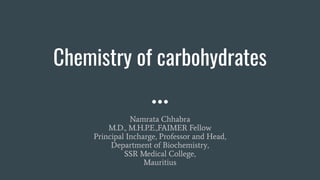
Chemistry of carbohydrates - General introduction and classification
- 1. Chemistry of carbohydrates Namrata Chhabra M.D., M.H.P.E.,FAIMER Fellow Principal Incharge, Professor and Head, Department of Biochemistry, SSR Medical College, Mauritius
- 4. Learning objectives ● What is the chemical nature of carbohydrates ● What are the functions of carbohydrates ● How can we classify carbohydrates ● Reflection ● Questions
- 5. Carbohydrates ○ Carbohydrates are the most abundant compounds found in nature (cellulose: 100 billion tons annually) ○ They make up most of the organic matter on Earth because of their extensive roles in all forms of life. ○ One of the four major classes of biomolecules along with proteins, nucleic acids and lipids.
- 6. What are carbohydrates ? ● The term carbohydrate is derived from the French term : hydrate de carbone, they are hydrates of carbon ● Compounds composed of C, H, and O ● Empirical formula (C. H2O)n , for example when n = 5 then C5H10O5 ● Not all carbohydrates have this empirical formula: e.g. sugar derivatives deoxy sugars, amino sugars etc., do not follow this rule.
- 7. General characteristics of carbohydrates ● They have large number of hydroxyl groups (poly hydroxy) ● In addition they may contain-an aldehyde group (poly hydroxy aldehydes) or a keto group (poly hydroxy ketones) ● Their derivatives may also contain nitrogen, phosphorus or sulfur.
- 8. Polyhydroxy aldehydes or ketones Carbohydrates are polyhydroxy aldehydes or polyhydroxy ketones (polyalcohol aldehydes or polyalcohol ketones).
- 9. Sugar derivatives with nitrogen, phosphorus and sulphur group
- 10. Functions of carbohydrates 1) Sources of energy, especially for brain and Red blood cells.
- 11. Functions of carbohydrates 2) Storage form of energy Glycogen, starch, inulin
- 12. Functions of carbohydrates 3) Form structural tissues in plants and in microorganisms
- 13. Functions of carbohydrates 4) Intermediates in the biosynthesis of other basic biochemical entities (fats and proteins)
- 14. Functions of carbohydrates 5) Ribose and deoxyribose sugars form part of the structural framework of RNA and DNA.
- 15. Functions of carbohydrates Carbohydrates are linked to many proteins and lipids, where they play key roles in mediating interactions among cells and interactions between cells and other elements in the cellular environment.
- 16. Classification of carbohydrates 1) Monosaccharides (monoses or glycoses) Trioses, Tetroses, Pentoses, Hexoses 2) Oligosaccharides Di, tri, tetra, penta, up to 9 or 10 Most important are the disaccharides 3) Polysaccharides or glycans a) Homopolysaccharides b) Heteropolysaccharides
- 17. Monosaccharides ● Also known as simple sugars ● Cannot be hydrolyzed further ● Sub classified either by the number of carbon atoms ● or ● by the nature of functional group-aldoses or ketoses
- 18. MONOSACCHARIDES - Classification 1-According to number of carbons they contain in their backbone structures- It is a variable prefix followed by the suffix (-ose): Trioses=3 Carbon, Tetroses=4C, Pentoses=5C, Hexoses=6C, Heptoses=7C
- 19. MONOSACCHARIDES - Classification 2- According to nature of reactive group - depending on the presence of Aldehyde or keto group: Aldose sugars e.g. glyceraldehyde Ketose sugars e.g. dihydroxyacetone
- 20. Aldoses
- 21. Ketoses
- 22. Summary of classification Number of carbon atoms Aldose Ketose 3 (Trioses) Glyceraldehyde Dihydroxyacetone 4 (Tetroses) Erythrose Erythrulose 5 (Pentoses) Ribose, Arabinose, Xylose Ribulose, Xylulose 6 (Hexoses) Glucose, Galactose, Mannose Fructose 7(Heptoses) - Sedoheptulose
- 23. Biological significance of monosaccharides • Monosaccharides are important fuel molecules as well as building blocks for nucleic acids.
- 24. Vote
- 25. Vote
- 26. Biological significance of monosaccharides • Trioses- Glyceraldehyde and dihydroxyacetone, in their phosphorylated forms are intermediates of glycolysis.
- 27. Biological significance of monosaccharides • Tetroses are intermediated of HMP (Hexose monophosphate) pathway, which is an intermediate pathway of glucose utilization
- 28. Biological significance of monosaccharides ● Pentoses form the structural components of glycoproteins, nucleotides and nucleic acids. ● They also serve as intermediates in the HMP pathway.
- 29. Biological significance of monosaccharides • Hexoses o Glucose is an important fuel molecule preferred source of energy for the brain cells and the only source of energy for the red blood cells and the cells lacking mitochondria. o Fructose- component of table sugar(Sucrose), honey and source of energy for the spermatozoa o Galactose- An important component of milk sugar (Lactose) o Mannose- An important component of glycoproteins.
- 30. Biological significance of monosaccharides • Heptoses- Sedoheptulose is an important intermediate of HMP pathway • Nonoses- Sialic acid is an important component of glycolipids.
- 32. Reflection
